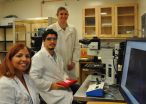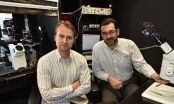An unpredictable disease that disrupts the flow of information within the brain and between the brain and the body, MS is triggered when the immune system attacks the myelin sheath, the protective covering around the axons of nerve fibers. The "demyelination" that follows causes a disruption of nerve impulses. As the protective sheath - best imagined as the insulating material around an electrical wire - wears off, the nerve signals slow down or stop, and the patient's vision, sensation and use of limbs get impaired. Permanent paralysis can result when the nerve fibers are completely damaged by the disease.
Given such debilitating effects, an aggressive search is on among scientists to find a cure for MS. Currently available therapies are only partially effective, however, in preventing the onset of permanent disability in MS patients. What would be immensely helpful is a drug that could minimize the degeneration of axons, thus reducing the rate and degree of MS progression. Better still would be if this drug could stimulate "remyelination," the re-sheathing of the axons, restoring fast and uninterrupted flow of nerve impulses.
Now a team of researchers, led by a biomedical scientist at the University of California, Riverside, reports in this week's issue of the Proceedings of the National Academy of Sciences that it has identified just such a drug in the lab: indazole chloride (Ind-Cl).
"This drug, which we administered on transgenic mice, can potentially halt the symptoms and reverse ongoing motor deficit due to MS," said Seema K. Tiwari-Woodruff, an associate professor in the UC Riverside School of Medicine whose lab led the study. "Our study shows that Ind-Cl can remyelinate axons which have gotten injured not just in MS but also traumatic brain injury and spinal cord injury."
Tiwari-Woodruff explained that Ind-Cl is a chemical compound that stimulates an estrogen receptor, ERβ, in the body. As is well known, pregnant women with MS get near-complete relief from MS symptoms in their third trimesters. Estrogen levels, which are high at this time, have neuroprotective benefits, alleviating the MS symptoms. After the birth of the baby, estrogen levels plummet in the mother and the MS symptoms return.
"This readily suggests that estrogen could be given to MS patients, except that high levels of estrogen are linked to breast and uterine cancers," said Tiwari-Woodruff, who joined UCR earlier this year. "Further, men would largely be reluctant to take estrogen due to its feminizing effects."
Enter Ind-Cl, a small compound Tiwari-Woodruff has worked with for about two years. This structurally unique ligand turns on the body's estrogen receptors without the negative effects of excessive estrogen.
"More encouraging is that this compound works after disease onset," Tiwari-Woodruff said. "This makes it promising because a patient with MS typically first visits the doctor when he or she has noticed some motor deficits - loss of balance, inability to pick up an object, an impairment in vision. By this time though, the axons responsible for these motor functions have been massively affected. But if a drug can be administered at this point that can help the patient gain some relief from the disease and further damage, we'd be on to something.
"Ind-Cl is just such a drug in that it inhibits selective inflammation of the central nervous system," Tiwari-Woodruff added. "Our work on mice suggests that its effect is permanent. But perhaps more significant, Ind-Cl remyelinates, that is, it makes new sheaths around those axons that have not been lost for good. This means Ind-Cl not only inhibits inflammation but is capable of reducing axon degeneration and restoring neuronal function."
Tiwari-Woodruff's lab conducted electrophysiology tests to ensure that the remyelinated axons were retransmitting impulses. According to her, Ind-Cl can be developed for oral administration. To ensure that the remyelination her team observed in the MS mice was due to Ind-Cl and not to an immune response, the team administered Ind-Cl in mice whose oligodendrocytes, the cells responsible for remyelinating axons and myelin, were selectively decreased.
"We found that remyelination occurred more efficiently in such mice after they were given Ind-Cl," Tiwari-Woodruff said. "This means Ind-Cl works in two ways: through the immune system in terms of reducing brain and spinal cord inflammation, and directly by remyelinating the axons. This makes it an extremely promising drug."
Tiwari-Woodruff noted that Ind-Cl can be tweaked to make analogs that could work even better at alleviating MS symptoms. Her colleague John A. Katzenellenbogen, an organic chemist at the University of Illinois at Urbana-Champaign (UIUC) and a coauthor on the research paper, developed Ind-Cl. In addition, his group has already identified four analogs that the research team will soon test on MS mice.
"We expect some of these analogs will soon go to clinical trial," Tiwari-Woodruff said.
INFORMATION:
Tiwari-Woodruff and Katzenellenbogen were joined in the study by Spencer M. Moore, Anna J. Khalaj, Zachary Winchester, JaeHee Yoon, Timothy Woo and Leonardo Martinez-Torres at UCR; Shalini Kumar at UCLA; and Norio Yasui at UIUC.
The research was funded by grants from the National Multiple Sclerosis Society and the National Institutes of Health.
What exactly causes MS is currently not known. It is commonly believed that a virus or gene defect and an active immune system is responsible for this neurodegenerative disease. Environmental factors could also play a role. The disease is seen in most ethnic groups, but is most common in Caucasians of northern European ancestry. Other MS information can be found here.
The University of California, Riverside is a doctoral research university, a living laboratory for groundbreaking exploration of issues critical to Inland Southern California, the state and communities around the world. Reflecting California's diverse culture, UCR's enrollment has exceeded 21,000 students. The campus opened a medical school in 2013 and has reached the heart of the Coachella Valley by way of the UCR Palm Desert Center. The campus has an annual statewide economic impact of more than $1 billion. A broadcast studio with fiber cable to the AT&T Hollywood hub is available for live or taped interviews. UCR also has ISDN for radio interviews. To learn more, call (951) UCR-NEWS. END





